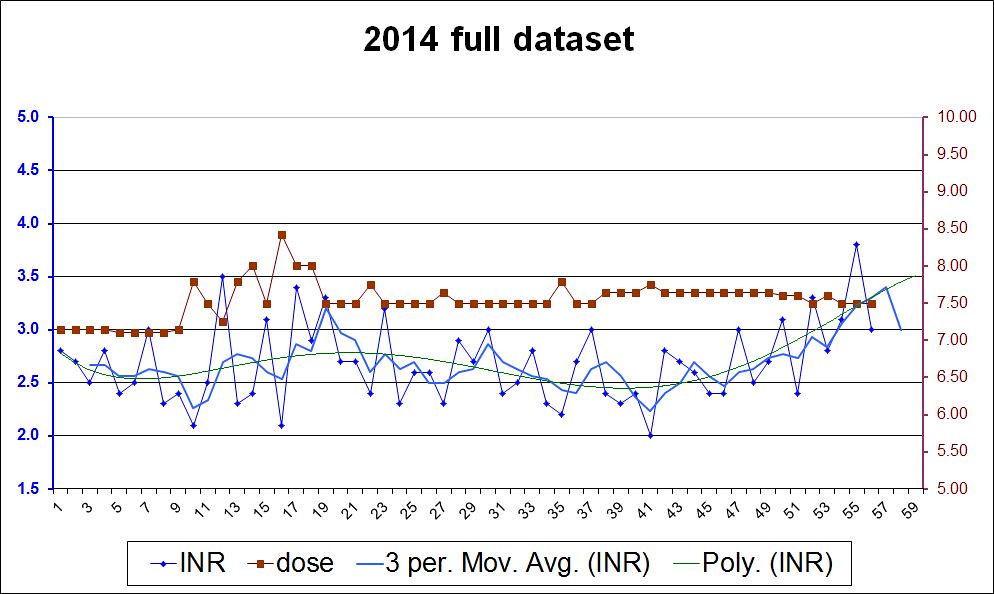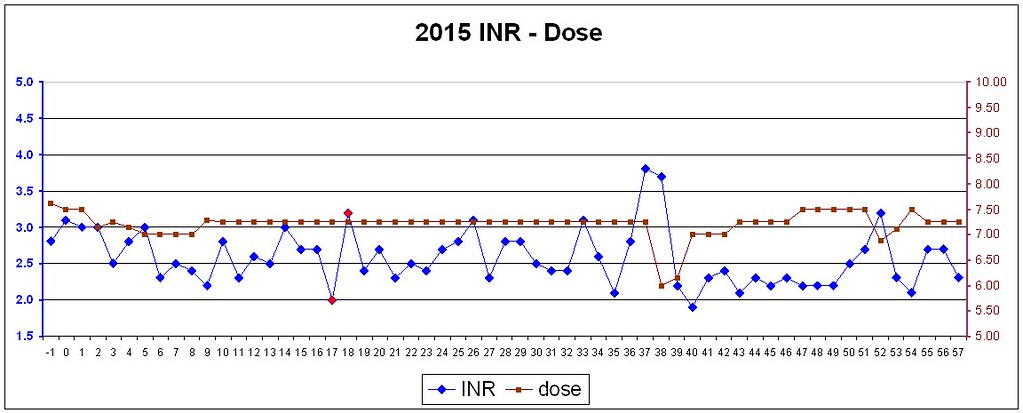Hi
I just observed that you're in Australia .. if you want to chinwag about this please PM me and we can exchange phone numbers. I'm on an Amaysim unlimited so I can chat as you wish.
Ryanvs;n866031 said:
Hello all. During the first few months of warfarin usuage did any struggle to keep it stable?
define "stable" ... my definition of stable is not out of range ... so I'm >90% stable ... if you think that the line will look straight ... well when you're flatline in all areas (aka dead).
Since pretty much ceasing daily pain medication (panodol) around 5/6 weeks ago my inr has dropped from 2.8 to 2.5 to 2.2 then last wel 1.9 and this week 1.7.
that's pretty normal - the interaction is well documented and also my observation for myself.
However what's important here is that testing picked up the shift
WELL BEFORE any harm could come from this. This is exactly why I strongly advocate you self test and self test weekly ... because its impossible to know and memorise all these interactions (even for a professional) so unles you're an IT based Expert System (IE a bit of software yourself ) then self testing is the best most reliable way to stay inside the lines ;-)
I guess that the hardest thing for newbies to get used to is that you don't suddently burst out bleeding with an INR over 3 nor suddenly become a giant clot with INR > 2 ... but it will come with time, experience and knowledge.
So needless to say i was surprised to see it drop after an increase in warfarin.
welcome to the wonderful world of evidence and reality not bullshit and myth spinning of idiots who aren't actually ON WARFARIN nor actually have the due dilligence to know the facts (when sitting across the office sounding important is more the business that matters to them).
I've been banging on about exactly this for years here ... citing evidence from my own '
self testing' and "
self experimentation" (often accidental, but as the Newcastle Song Lycrics suggest - to never let a chance go by )
The machines are actually cheapest in the world here in Australia right now, because they don't seem to have caught up with the USDollar changes ... so buy one right now before they go up when local stock runs out. PM me about that if your budget is super tight.
Strips online are (as you suggest later) about $150 including shipping for 24 strips Which when you think about it is less money per test than gets getting to the testing center and wasting time waiting for a blood draw (not to mention times in the week where you can spend time wasting time).
I recommend strongly that you watch my video on my blog post and bookmark my blog post for reference. Its well known that students get about 10% out of a lecture and even though my video is only 45 seconds long there is a LOT in there. Nothing is mistake (except my not properlly setting the lance) and every aspect is significant.
I said to Agian recently about this and to do a dry run a few times before ... but he blew a few strips anyway.
Reminds me ... I should call tomorrow and see how he went, he'll be under the knife today.
Blog posts:
http://cjeastwd.blogspot.com/2014/09...ng-my-inr.html
and
http://cjeastwd.blogspot.com/2014/05...ocks-dose.html
When you start self management (because you'll come to realise the stories about the clinics are not an exaggeration) you may want a spreadsheet, let me know and I'll share a google sheet with you and help you to get started.



























